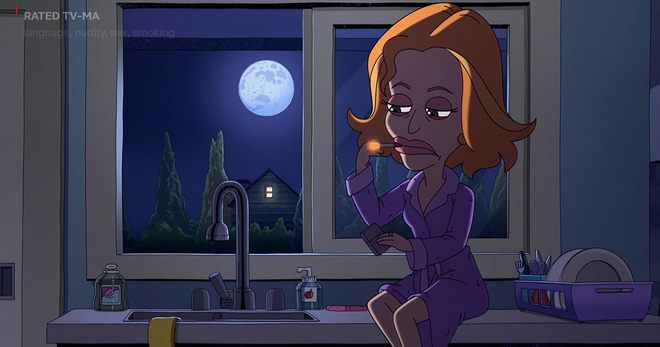What can streaming services do about exposing youth to on-screen smoking?
Truth Initiative® report found that tobacco use in online streaming series such as “Stranger Things,” “House of Cards” and “Orange Is the New Black” is pervasive, rising and more prominent than in broadcast and cable shows. Given the popularity and impact of streaming content among young viewers, do streaming services have a responsibility to address this issue?
The report, “While You Were Streaming,” revealed that, among a sample of the 14 shows most popular with young people ages 15 to 24, the seven Netflix shows contained more tobacco depictions (319) than the seven broadcast and cable television shows (139). Researchers found that, overall, 79 percent of the shows depicted smoking prominently. The report warns that smoking is being re-normalized on screen, and views the findings as an opportunity for streaming content providers to heed the lessons learned from the motion picture industry.
In 2012, the surgeon general concluded that exposure to smoking in movies causes young people to smoke. In fact, youth and young adults with more exposure to tobacco in movies are twice as likely to begin smoking, compared with those with less exposure. By 2013, all six major studios in the Motion Picture Association of America — Comcast, Disney, Fox, Sony, Time Warner and Viacom — adopted policies regarding tobacco depictions in their youth-rated G, PG and PG-13 films, according to Smokefree Movies. Some similar procedures in these policies include:
- Having no, or discouraging, tobacco use in youth-rated films (with the common exception of allowing tobacco use if it is part of the historical, biographical or cultural context, if it depicts negative health effects or if there is a compelling reason to do so from a creative perspective)
- Prohibiting product placement or promotion deals with tobacco companies, and limiting tobacco branding
- Including anti-smoking public service announcements on DVDs of films that contain tobacco use
Despite these policies, tobacco depictions have persisted in youth-rated films. The percentage of PG-13 movies with tobacco incidents increased from 35 percent in 2016 to 50 percent in 2017 — the highest it’s been since 2009, according to the Centers for Disease Control and Prevention. The CDC also found that, in 2017, theater audiences saw 4.6 billion tobacco incidents in youth-rated G, PG and PG-13 movies, a 59 percent increase from 2015.
Because major studios adopted varying policies that have delivered mixed results, a CDC report recommended a uniform solution: giving an R rating to all films that include depictions of smoking or tobacco, which would prevent up to a million deaths among children and teens alive today. In response to the report, 17 public health and medical groups, including Truth Initiative, signed a letter to film industry leaders challenging them to apply an R rating to movies that depict smoking or tobacco use by June 1, 2018. On June 4, seven U.S. senators sent a letter to the MPAA urging the association to “ensure responsible and consistent practices and reduce tobacco depictions” in youth-rated movies.
One of the first steps to get smoking out of entertainment media happened in 1971, when the Department of Justice banned cigarette ads on TV and radio. Ads for smokeless tobacco products on TV and radio were banned in 1986. For decades after, tobacco advertisement bans on TV and radiolimited some of the popular and positive depictions of tobacco use.
While federal regulations have led to less tobacco imagery on broadcast TV and major film studios have adopted policies to reduce tobacco imagery in movies, those gains may be weakened by newer forms of online streaming content. “While You Were Streaming” suggested several measures to protect young viewers from tobacco imagery, including:
- Conducting additional research on tobacco on TV
- Monitoring programming on streaming platforms more closely
- Changing state public subsidy policies to provide tax and other incentives for productions that do not promote tobacco use
- Enforcing stricter ratings on TV shows that include tobacco
- Working in partnership with creators and distributors to ensure future content does not include tobacco imagery
“The lessons that can be drawn from the past are threefold,” the report states. “These findings are just the beginning of that process with regard to smoking on all of our screens.”
Following “While You Were Streaming,” Truth Initiative convened public health experts, entertainment industry professionals and youth at its most recent Kenneth E. Warner Series to discuss the impact of tobacco imagery in culture. The panel explored why tobacco imagery is making a resurgence and whether entertainment companies have a responsibility to address the issue of tobacco use on screen.
For more information on this topic, read the Truth Initiative report “While You Were Streaming: Tobacco Use Sees a Renormalization in On-Demand Digital Content, Diluting Progress in Broadcast & Theaters” and watch the Truth Initiative Warner Series “Tobacco in culture: The renormalization and glamorization of smoking.”
More in tobacco in pop culture
Want support quitting? Join EX Program
By clicking JOIN, you agree to the Terms, Text Message Terms and Privacy Policy.
Msg&Data rates may apply; msgs are automated.



